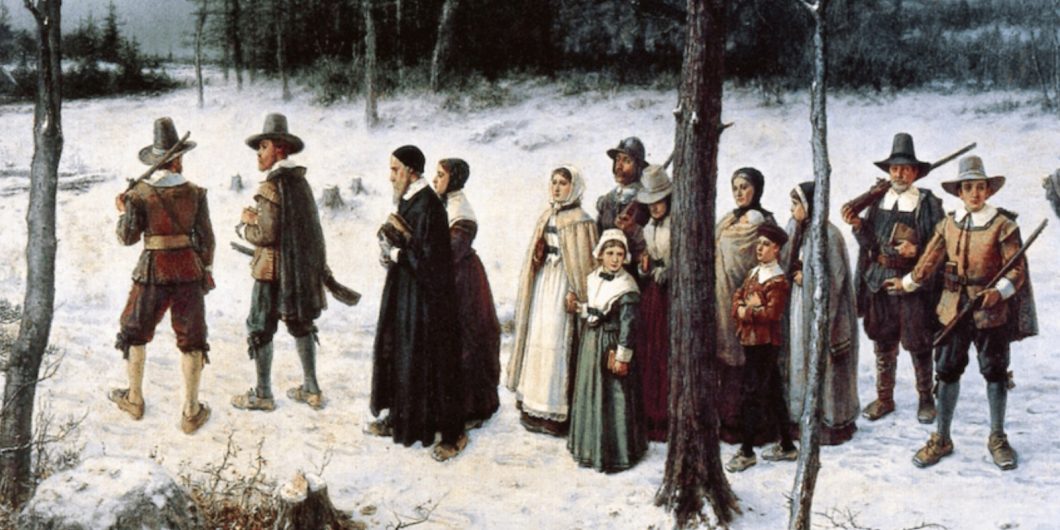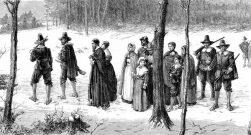A Lifeless Account of the Pilgrims
For many Americans, Plymouth and the Pilgrims exist somewhere in the realm of American mythology. It happened somewhere off the eastern coastline of the United States, and it involved people from some distant time coming to some remote place in the pursuit of religious liberty. They also wore black, had funny hats, and were somewhat grim. They would have been no fun at dinner parties. With the 400th anniversary of the Mayflower’s arrival to the so-called New World, a host of scholars had produced works to mark the occasion, many of which are aimed precisely at correcting the errors concerning the Pilgrims as well as debunking the traditions surrounding them. One can wonder what a non-COVID-19 remembrance of the Mayflower landing would have looked like, but other activities have marked the occasion, most notably the renaming of Plymouth Plantation to Plimouth Patuxet Museums in June of this year, as well as the launching of the 1620 project, a response to the New York Times’ 1619 Project. Also entering into this crowded space is UCLA’s Carla Gardina Pestana with The World of Plymouth Plantation.
While many cultural thinkers, politicians, and historians have pointed to Plymouth and other colonial settlements as part of the United States’ origin (in both complimentary and negative ways), Pestana’s The World of Plymouth Plantation positions itself almost as the anti-origin story. According to Pestana, at the heart of this origin story fixation is how Plymouth has come to be understood only as a “symbol of large, abstract concepts” which only serves to lay the foundation of a forthcoming American democracy. This backward-looking and ongoing preoccupation for most Americans, while understandable, is not healthy in Pestana’s view and has been the source of all kinds of historical anachronisms. Fundamental to The World of Plymouth Plantation is the fact that the Pilgrims did not want “to begin the world over again” but rather recreate and improve upon the world they already knew.
Because of this, rather than looking deeply into the lives of the pilgrims, Pestana presents readers with their world. From what they ate, to what they wore, to what tools they used to hunt, what songs they sang, and what kind of houses they lived in, the book is rich in detail. Beyond their materials and means, Pestana also conveys the settlers’ customs and beliefs, concerning themselves, the land they found themselves in, and those with whom they shared it. All of this is by design, in the hope of breaking away from the symbolic value of Plymouth Plantation to the American founding mythology and psychology and restoring it to “a real place in which people lived, worked, and died.” As she puts it, her goal is to depict “the reality of the lives of its inhabitants”.
Far from the paintings that depict a unified community, what emerges from Pestana’s depiction is a Plymouth colony of a more transient nature, a community almost always in flux.
Given the mythology that has developed around the pilgrims as separatists hellbent on breaking away from England and laying the groundwork for the future American identity, Pestana emphasizes the “English” quality and character to the world Plymouth made. By doing so, Pestana reveals the great deal of continuity that existed for the settlers, as well as their desire to transport and recreate their English lifestyle on this new soil. Beyond the desire for English foods and goods, Plymouth sought to establish English gender norms and class hierarchies. Thus, they were “planters” in numerous senses, interested in “transplanting the society they knew as well as well as the household work regimens that made it possible.”
Akin to John G. Turner’s They Knew They Were Pilgrims: Plymouth Colony and the Contest for American Liberty, Pestana pushes back against the idea that Plymouth was an ignored backwater or isolated outpost. Whereas Turner highlights the networks Plymouth colony developed among the other English settlements and to the happenings back in the mother country, Pestana emphasizes the immigration to and from, as well as the trade with, Plymouth from the rest of Europe. Much of this interconnectedness was driven out of survival and economic interest, but with the movement of goods and people (as well as people being sold as goods) came competing ideas and faiths. Far from the paintings that depict a unified community, what emerges is a Plymouth colony of a more transient nature, a community almost always in flux. But while the people might come and go, the real subject of Pestana’s work, the world they attempted to make, is far more fixed.
The book is organized around some of Plymouth Plantation’s most important objects, things, and roles, such as “Wives,” “Guns,” “God,” “Tobacco,” “Furs,” and “Books” to name a few. Almost all of these chapters and their related sections are both incredibly short and thorough. All of this makes for easy but instructive reading. But the lack of focus on human agents and historical actors brings out one of the core problems with The World of Plymouth Plantation. For all the wonderful detail on what clothing settlers donned and how they cooked their meals, the book, sadly, is incredibly lifeless. As there is no narrative to the study, the flow of the book cannot help but feel off and leave the reader wondering who such descriptions might have applied to.
Material histories certainly have their place and they have been growing in popularity and influence, both inside and outside the academy. But such studies require the “thick description” championed by Clifford Geertz in order to understand more fully the world being studied. I found this to be particularly true of Pestanta’s all too brief handling of the notorious Thomas Morton. Given her interest in materials, I expected Morton and his Maypole would be the perfect figure for her to study, bringing forth the intersection of ideas, objects, and people. But this was not to be, and much like the rest of the figures in the book, Morton the man was already in the distance. Because so many of the other books written about Plymouth have focused on the individuals within and around the colony, Pestana’s contribution is best consumed as additional reading. It will certainly enhance the knowledge of those familiar with the people of Plymouth Plantation, but I cannot recommend it for the uninitiated.
The World of Plymouth Plantation is admirable in its myth-busting qualities and unquestionably insightful but is limited by its lack of human focus.



